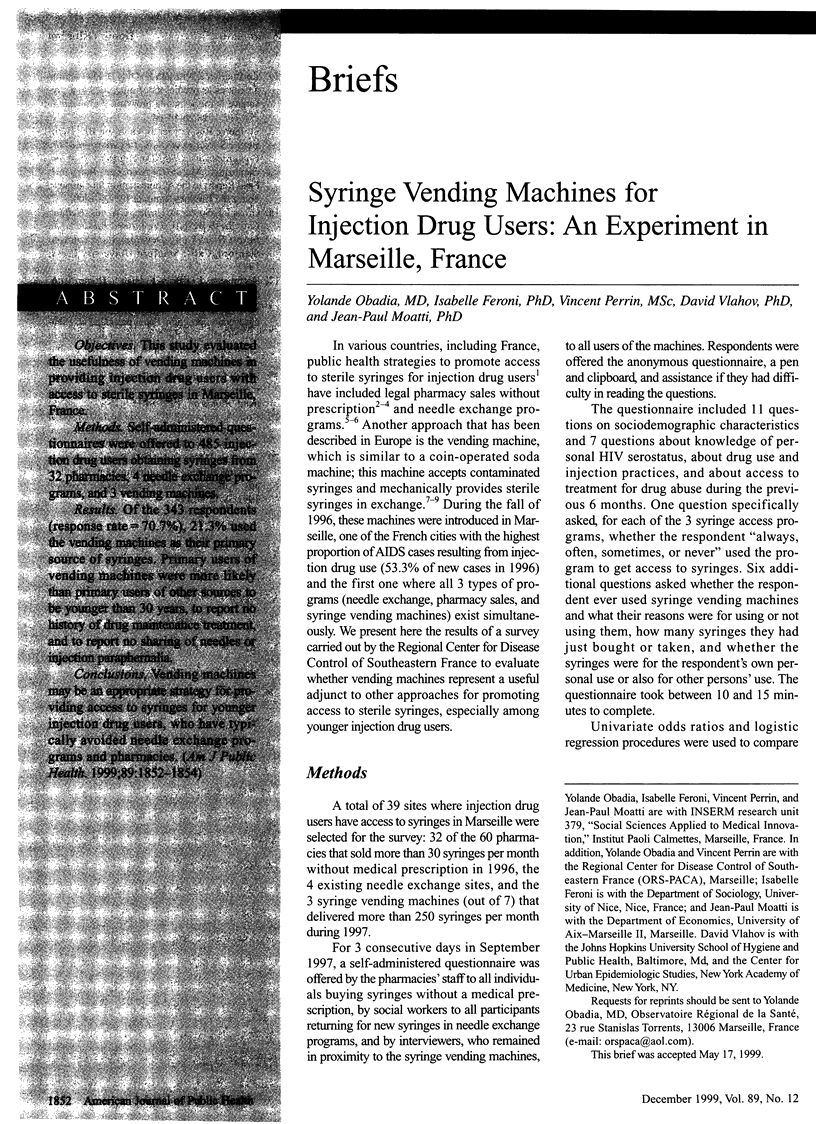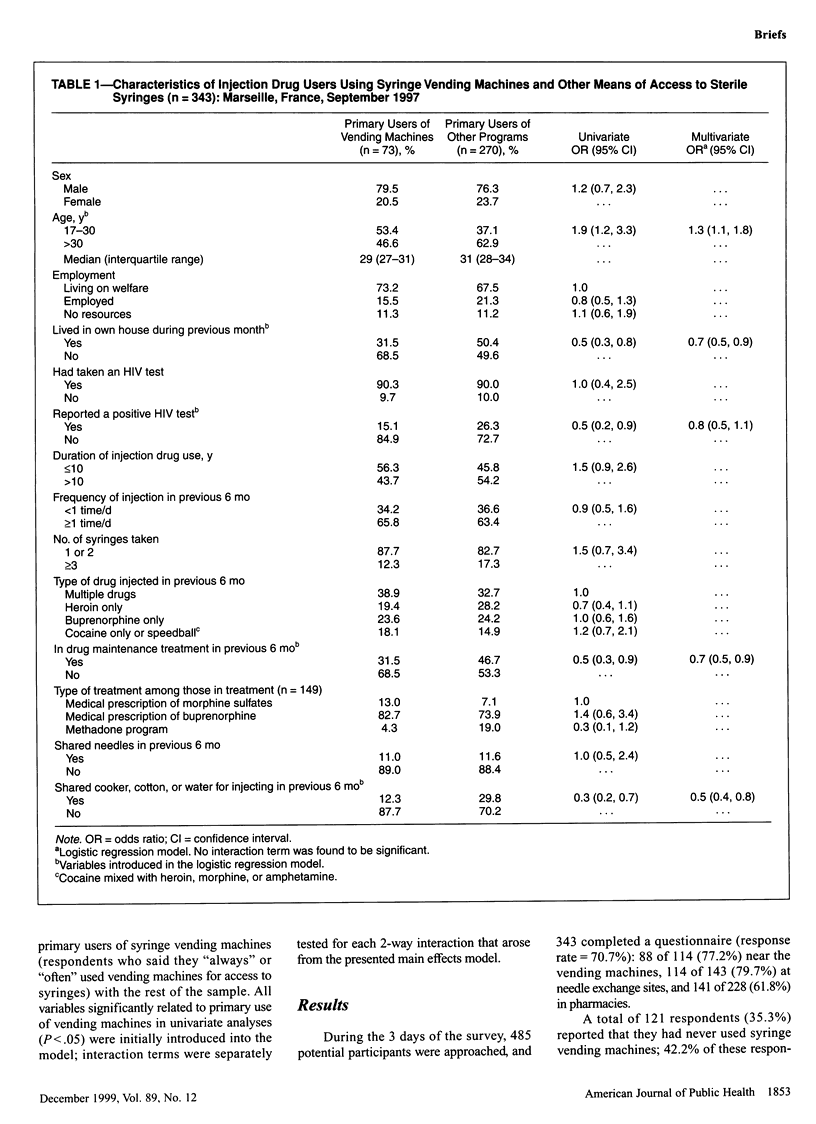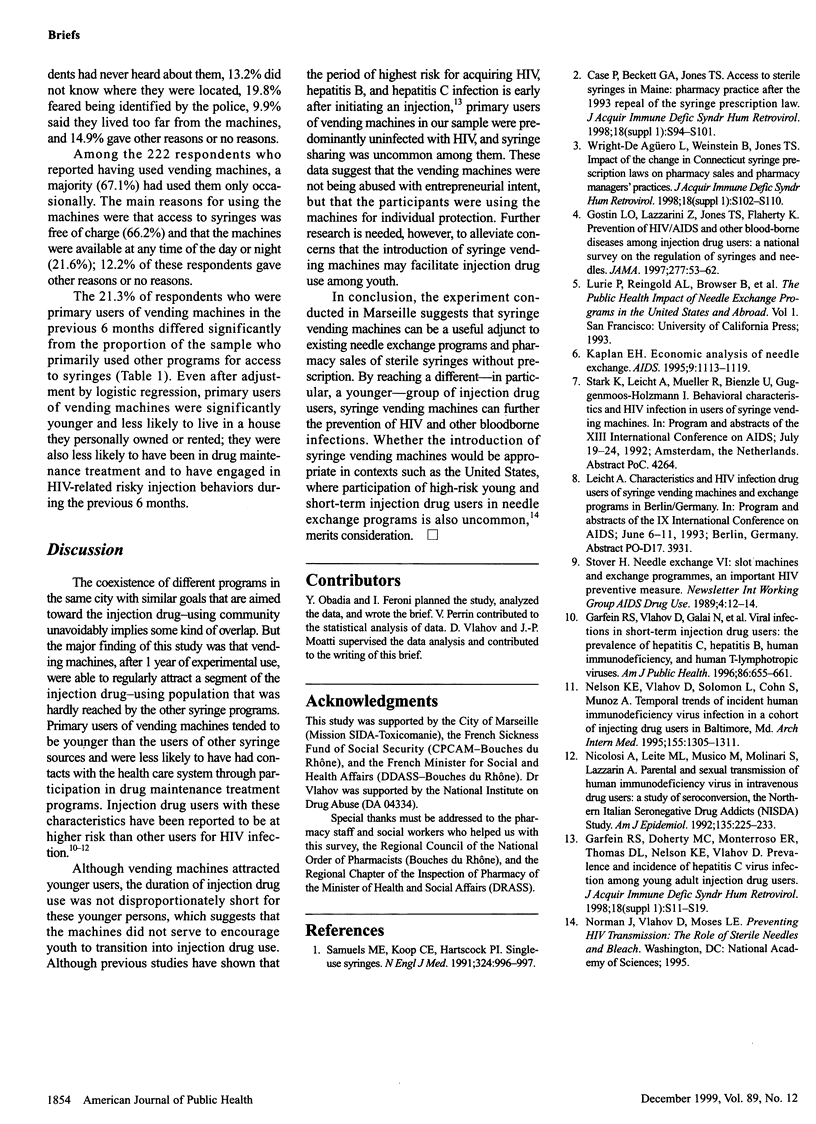Abstract
OBJECTIVES: This study evaluated the usefulness of vending machines in providing injection drug users with access to sterile syringes in Marseille, France. METHODS: Self-administered questionnaires were offered to 485 injection drug users obtaining syringes from 32 pharmacies, 4 needle exchange programs, and 3 vending machines. RESULTS: Of the 343 respondents (response rate = 70.7%), 21.3% used the vending machines as their primary source of syringes. Primary users of vending machines were more likely than primary users of other sources to be younger than 30 years, to report no history of drug maintenance treatment, and to report no sharing of needles or injection paraphernalia. CONCLUSIONS: Vending machines may be an appropriate strategy for providing access to syringes for younger injection drug users, who have typically avoided needle exchange programs and pharmacies.
Full text
PDF


Selected References
These references are in PubMed. This may not be the complete list of references from this article.
- Case P., Beckett G. A., Jones T. S. Access to sterile syringes in Maine: pharmacy practice after the 1993 repeal of the syringe prescription law. J Acquir Immune Defic Syndr Hum Retrovirol. 1998;18 (Suppl 1):S94–101. doi: 10.1097/00042560-199802001-00017. [DOI] [PubMed] [Google Scholar]
- Garfein R. S., Doherty M. C., Monterroso E. R., Thomas D. L., Nelson K. E., Vlahov D. Prevalence and incidence of hepatitis C virus infection among young adult injection drug users. J Acquir Immune Defic Syndr Hum Retrovirol. 1998;18 (Suppl 1):S11–S19. doi: 10.1097/00042560-199802001-00004. [DOI] [PubMed] [Google Scholar]
- Garfein R. S., Vlahov D., Galai N., Doherty M. C., Nelson K. E. Viral infections in short-term injection drug users: the prevalence of the hepatitis C, hepatitis B, human immunodeficiency, and human T-lymphotropic viruses. Am J Public Health. 1996 May;86(5):655–661. doi: 10.2105/ajph.86.5.655. [DOI] [PMC free article] [PubMed] [Google Scholar]
- Gostin L. O., Lazzarini Z., Jones T. S., Flaherty K. Prevention of HIV/AIDS and other blood-borne diseases among injection drug users. A national survey on the regulation of syringes and needles. JAMA. 1997 Jan 1;277(1):53–62. [PubMed] [Google Scholar]
- Kaplan E. H. Economic analysis of needle exchange. AIDS. 1995 Oct;9(10):1113–1119. doi: 10.1097/00002030-199510000-00001. [DOI] [PubMed] [Google Scholar]
- Nelson K. E., Vlahov D., Solomon L., Cohn S., Muñoz A. Temporal trends of incident human immunodeficiency virus infection in a cohort of injecting drug users in Baltimore, Md. Arch Intern Med. 1995 Jun 26;155(12):1305–1311. [PubMed] [Google Scholar]
- Nicolosi A., Leite M. L., Musicco M., Molinari S., Lazzarin A. Parenteral and sexual transmission of human immunodeficiency virus in intravenous drug users: a study of seroconversion. The Northern Italian Seronegative Drug Addicts (NISDA) Study. Am J Epidemiol. 1992 Feb 1;135(3):225–233. doi: 10.1093/oxfordjournals.aje.a116275. [DOI] [PubMed] [Google Scholar]
- Samuels M. E., Koop C. E., Hartsock P. I. Single-use syringes. N Engl J Med. 1991 Apr 4;324(14):996–997. doi: 10.1056/NEJM199104043241415. [DOI] [PubMed] [Google Scholar]
- Wright-De Agüero L., Weinstein B., Jones T. S., Miles J. Impact of the change in Connecticut syringe prescription laws on pharmacy sales and pharmacy managers' practices. J Acquir Immune Defic Syndr Hum Retrovirol. 1998;18 (Suppl 1):S102–S110. doi: 10.1097/00042560-199802001-00018. [DOI] [PubMed] [Google Scholar]


